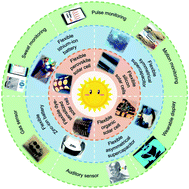Recent advances in wearable self-powered energy systems based on flexible energy storage devices integrated with flexible solar cells
Abstract
Wearable electronics are considered to be an important technology in next-generation smart electronics. Meanwhile, the ever-increasing energy consumption and the growing environmental awareness have highlighted the requirements of green and renewable energy. Integrating flexible photovoltaic cells (PVCs) with flexible energy storage devices (ESDs) to construct self-sustaining energy systems not only provides a promising strategy to address the energy and environmental issues, but also enables the entire system to be operated continuously without external charging, which is considered to be a promising direction for future wearable electronics. Herein, we summarize the recent progress in wearable self-sustaining energy systems based on flexible ESDs integrated with flexible PVCs. First, the recent developments in flexible PVCs and their characteristics are summarized. Following that, we discuss the advances in flexible ESDs used in wearable electronics. Then, we give a short discussion on the integration of flexible ESDs with flexible PVCs. Thereafter, various functional applications of these self-sustaining energy systems in wearable electronics are introduced. Finally, the main challenges and future prospects of self-powered energy systems for wearable electronics are discussed.

- This article is part of the themed collection: Journal of Materials Chemistry A Emerging Investigators


 Please wait while we load your content...
Please wait while we load your content...